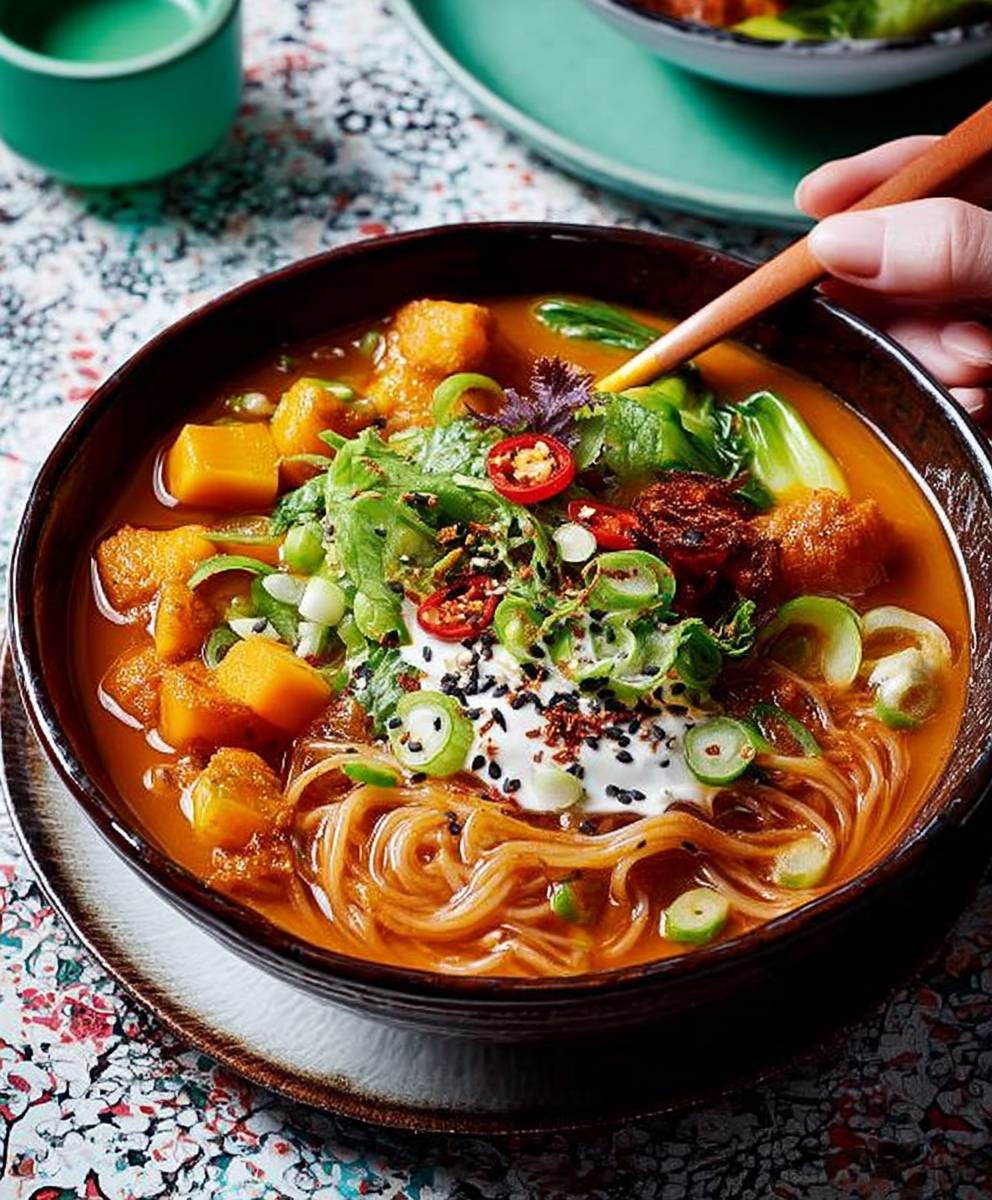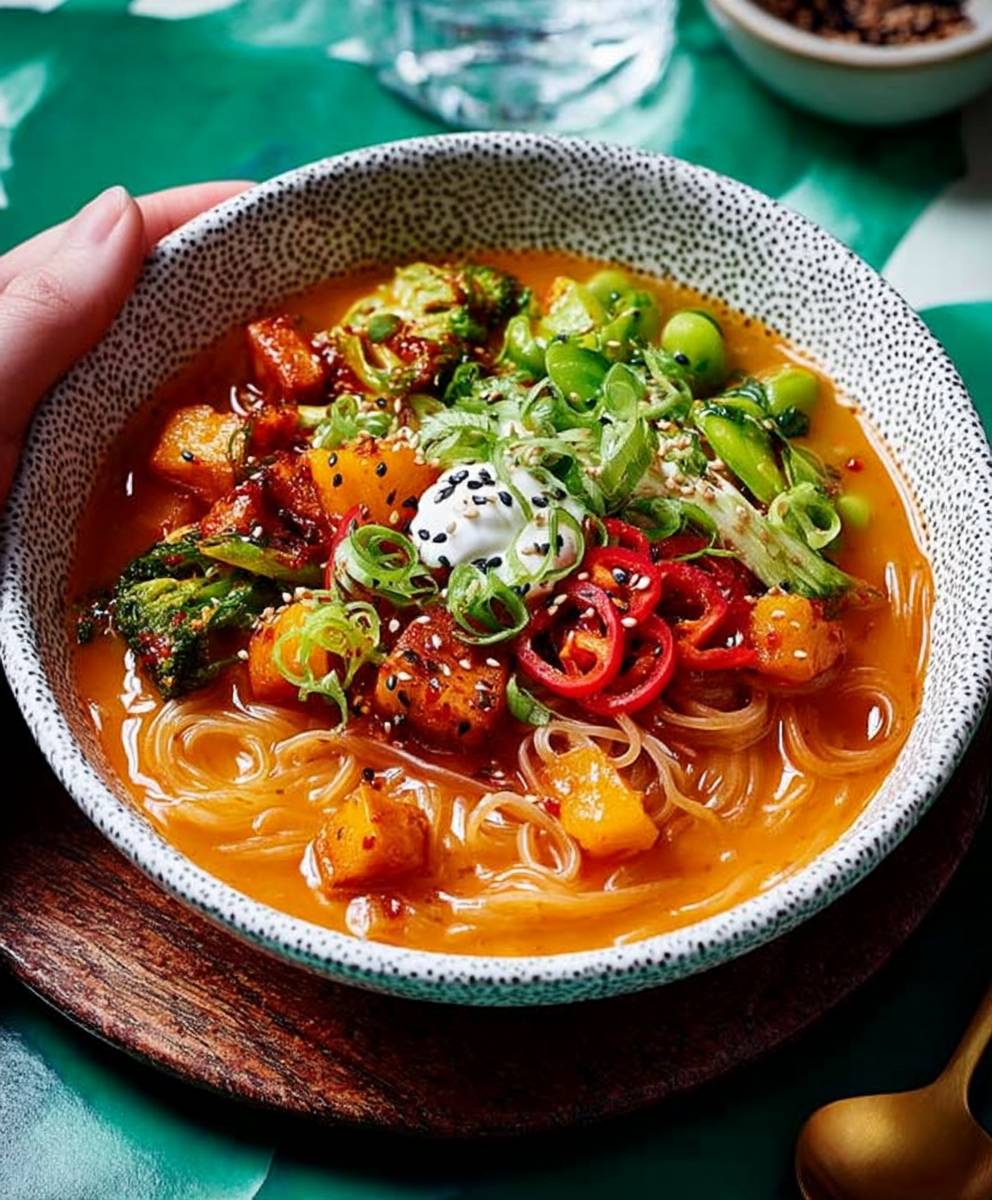Gochujang squash noodle soup: prepare to be utterly captivated by a symphony of flavors and textures! Imagine a warm, comforting bowl brimming with tender squash noodles, bathed in a vibrant, spicy-sweet broth that dances on your palate. This isn’t just soup; it’s an experience.
The star of this dish, gochujang, is a fermented Korean chili paste with a history as rich and complex as its flavor. For centuries, gochujang has been a staple in Korean cuisine, adding depth and character to countless dishes. Its more than just heat; it’s a complex blend of umami, sweetness, and a subtle funk that elevates everything it touches. This gochujang squash noodle soup is a testament to its versatility.
People adore this soup for its incredible balance. The sweetness of the squash perfectly complements the fiery gochujang, while the noodles provide a satisfying chewiness. It’s a dish that’s both comforting and exciting, perfect for a chilly evening or a quick and flavorful lunch. Plus, it’s surprisingly easy to make, making it a weeknight winner. Get ready to discover your new favorite way to enjoy squash!
Ingredients:
- 1 large butternut squash (about 2-2.5 lbs), peeled, seeded, and spiralized into noodles (or use pre-made squash noodles)
- 2 tablespoons olive oil
- 1 large onion, chopped
- 2 cloves garlic, minced
- 1 inch ginger, grated
- 1 red bell pepper, thinly sliced
- 4 cups vegetable broth
- 2 tablespoons gochujang (Korean chili paste), adjust to taste
- 1 tablespoon soy sauce (or tamari for gluten-free)
- 1 teaspoon sesame oil
- 1/2 teaspoon red pepper flakes (optional, for extra heat)
- 1/4 cup chopped green onions, for garnish
- 2 tablespoons sesame seeds, for garnish
- 1 cup chopped shiitake mushrooms
- 1 block firm tofu, pressed and cubed (optional, for protein)
- 1 cup baby spinach
- Salt and pepper to taste
- 1 tablespoon rice vinegar (optional, for brightness)
Preparing the Base:
- Heat the olive oil in a large pot or Dutch oven over medium heat. Add the chopped onion and cook until softened, about 5-7 minutes. Stir occasionally to prevent burning. We want the onions to be translucent and slightly golden.
- Add the minced garlic and grated ginger to the pot. Cook for another minute, until fragrant. Be careful not to burn the garlic, as it can become bitter. The aroma should be quite inviting at this point!
- Stir in the sliced red bell pepper and chopped shiitake mushrooms. Cook for 5-7 minutes, until the bell pepper is slightly softened and the mushrooms have released their moisture and started to brown. This step builds a lot of flavor, so don’t rush it.
Building the Broth:
- Pour in the vegetable broth. Bring the mixture to a simmer.
- In a small bowl, whisk together the gochujang, soy sauce (or tamari), and sesame oil. This ensures the gochujang is evenly distributed in the broth and doesn’t clump up.
- Add the gochujang mixture to the pot and stir well to combine. Add the red pepper flakes if you’re using them.
- If you’re using tofu, add the pressed and cubed tofu to the pot. Simmer for 5-10 minutes to allow the tofu to absorb some of the flavor of the broth. This will make the tofu much more enjoyable in the final dish.
- Season the broth with salt and pepper to taste. Remember that gochujang and soy sauce are already salty, so start with a small amount and adjust as needed.
Cooking the Squash Noodles:
- Add the spiralized butternut squash noodles to the pot. Gently stir to submerge them in the broth.
- Cook for 3-5 minutes, or until the squash noodles are tender-crisp. Be careful not to overcook them, as they can become mushy. We want them to retain a bit of bite.
- Stir in the baby spinach and cook until wilted, about 1 minute. The spinach will add a nice pop of color and nutrients to the soup.
- Taste the soup and adjust the seasoning as needed. If you want a brighter flavor, add a tablespoon of rice vinegar.
Serving and Garnishing:
- Ladle the Gochujang Squash Noodle Soup into bowls.
- Garnish with chopped green onions and sesame seeds.
- Serve immediately and enjoy! This soup is delicious on its own or with a side of kimchi.
Tips and Variations:
- Spice Level: Adjust the amount of gochujang and red pepper flakes to your liking. If you’re sensitive to spice, start with a smaller amount of gochujang and add more as needed.
- Protein: Feel free to add other protein sources, such as cooked chicken, shrimp, or edamame.
- Vegetables: You can also add other vegetables, such as carrots, zucchini, or bok choy.
- Noodle Alternatives: If you don’t have squash noodles, you can use other types of noodles, such as rice noodles, soba noodles, or udon noodles.
- Make it Vegan: Ensure your vegetable broth is vegan-friendly.
- Broth Enhancement: For a richer broth, consider adding a piece of dried kombu (kelp) while simmering. Remove it before serving.
- Leftovers: This soup is even better the next day! Store leftovers in an airtight container in the refrigerator for up to 3 days.
Detailed Notes on Ingredients:
- Butternut Squash: Freshly spiralized butternut squash noodles are best, but pre-made ones are a convenient option. If using pre-made, check the package for cooking instructions, as they may vary.
- Gochujang: Gochujang is a fermented Korean chili paste that adds a unique flavor and spice to the soup. You can find it in most Asian grocery stores or online. Different brands have varying levels of spiciness, so start with a smaller amount and adjust to taste.
- Soy Sauce/Tamari: Use soy sauce for a classic flavor, or tamari for a gluten-free option. Low-sodium soy sauce is also a good choice if you’re watching your sodium intake.
- Vegetable Broth: Use a good quality vegetable broth for the best flavor. Homemade vegetable broth is even better!
- Tofu: Firm or extra-firm tofu works best in this recipe. Pressing the tofu removes excess water and allows it to absorb more flavor. To press tofu, wrap it in paper towels and place a heavy object on top for about 30 minutes.
- Shiitake Mushrooms: Shiitake mushrooms add a meaty and umami flavor to the soup. You can use fresh or dried shiitake mushrooms. If using dried, rehydrate them in hot water for about 30 minutes before using.
- Sesame Oil: Sesame oil adds a nutty and aromatic flavor to the soup. Use toasted sesame oil for the best flavor.
- Green Onions: Green onions add a fresh and mild onion flavor to the soup. Use the green parts for garnish.
- Sesame Seeds: Sesame seeds add a nutty flavor and a nice crunch to the soup. You can use white or black sesame seeds.
Step-by-Step Visual Guide (Optional):
While I can’t provide actual images here, imagine each step with a corresponding photo:
- Step 1: Photo of chopped onions softening in olive oil in a pot.
- Step 2: Photo of minced garlic and ginger being added to the pot.
- Step 3: Photo of sliced red bell pepper and mushrooms cooking in the pot.
- Step 4: Photo of vegetable broth being poured into the pot.
- Step 5: Photo of gochujang, soy sauce, and sesame oil being whisked together in a bowl.
- Step 6: Photo of the gochujang mixture being added to the pot.
- Step 7: Photo of tofu cubes simmering in the broth.
- Step 8: Photo of squash noodles being added to the pot.
- Step 9: Photo of spinach being stirred into the soup.
- Step 10: Photo of the finished soup being ladled into a bowl and garnished with green onions and sesame seeds.
This soup is a delightful and healthy way to enjoy the flavors of Korean cuisine with a twist. The butternut squash noodles provide a satisfying and nutritious alternative to traditional noodles, and the gochujang adds a delicious kick of spice. Enjoy!

Conclusion:
So, there you have it! This Gochujang squash noodle soup isn’t just another recipe; it’s a flavor adventure waiting to happen. I truly believe this is a must-try because it perfectly balances the sweetness of the squash with the fiery kick of gochujang, all nestled in a comforting, slurpable broth. Its a surprisingly simple dish that delivers a complex and deeply satisfying experience. The vibrant color alone is enough to brighten any day, and the aroma that fills your kitchen while it simmers is simply divine.
But beyond the taste, this soup is incredibly versatile. Looking for serving suggestions? I love topping mine with a sprinkle of toasted sesame seeds and a dollop of Greek yogurt or sour cream to add a cool, tangy contrast to the spice. A few chopped scallions or cilantro leaves also add a fresh, herbaceous note. For a heartier meal, consider adding some pan-fried tofu or shredded chicken. If you’re feeling adventurous, a soft-boiled egg adds richness and a beautiful visual element.
And speaking of variations, the possibilities are endless! If you’re not a fan of squash, sweet potatoes or butternut squash would work beautifully. You could also experiment with different types of noodles udon, ramen, or even soba noodles would all be delicious. For a vegetarian version, ensure your gochujang paste is vegetarian-friendly (some contain fish sauce). To amp up the heat, add a pinch of red pepper flakes or a drizzle of chili oil. If you prefer a milder flavor, start with a smaller amount of gochujang and adjust to your liking. You can even add a splash of lime juice at the end for a brighter, more citrusy flavor.
Why This Gochujang Squash Noodle Soup is a Winner
This recipe is a winner because it’s:
* Easy to make: Minimal ingredients and straightforward instructions mean you can have a delicious and satisfying meal on the table in under an hour.
* Packed with flavor: The combination of sweet squash, spicy gochujang, and savory broth creates a truly unforgettable taste experience.
* Versatile: Easily adaptable to your dietary needs and preferences.
* Healthy: Loaded with vitamins and nutrients from the squash and other vegetables.
* Comforting: A warm and satisfying bowl of soup is the perfect way to cozy up on a chilly day.
Im so excited for you to try this recipe and discover your own favorite variations. I poured my heart into creating this recipe, and I truly believe you’ll love it as much as I do. Don’t be intimidated by the gochujang; it’s a wonderfully complex ingredient that adds so much depth and character to the soup.
So, what are you waiting for? Head to your kitchen, gather your ingredients, and get ready to create a culinary masterpiece! I can’t wait to hear about your experience with this Gochujang squash noodle soup. Please, share your photos and comments with me I’m eager to see your creations and hear your feedback. Let me know what variations you tried and what you thought of the overall flavor. Happy cooking!
Gochujang Squash Noodle Soup: A Spicy & Comforting Recipe
Spicy Gochujang Squash Noodle Soup with butternut squash noodles, tofu, and Korean chili paste. A healthy and delicious twist on noodle soup!
Ingredients
- 1 large butternut squash (about 2-2.5 lbs), peeled, seeded, and spiralized into noodles (or use pre-made squash noodles)
- 2 tablespoons olive oil
- 1 large onion, chopped
- 2 cloves garlic, minced
- 1 inch ginger, grated
- 1 red bell pepper, thinly sliced
- 4 cups vegetable broth
- 2 tablespoons gochujang (Korean chili paste), adjust to taste
- 1 tablespoon soy sauce (or tamari for gluten-free)
- 1 teaspoon sesame oil
- 1/2 teaspoon red pepper flakes (optional, for extra heat)
- 1/4 cup chopped green onions, for garnish
- 2 tablespoons sesame seeds, for garnish
- 1 cup chopped shiitake mushrooms
- 1 block firm tofu, pressed and cubed (optional, for protein)
- 1 cup baby spinach
- Salt and pepper to taste
- 1 tablespoon rice vinegar (optional, for brightness)
Instructions
- Heat the olive oil in a large pot or Dutch oven over medium heat. Add the chopped onion and cook until softened, about 5-7 minutes, stirring occasionally. Add the minced garlic and grated ginger and cook for another minute, until fragrant. Stir in the sliced red bell pepper and chopped shiitake mushrooms. Cook for 5-7 minutes, until the bell pepper is slightly softened and the mushrooms have released their moisture and started to brown.
- Pour in the vegetable broth and bring to a simmer. In a small bowl, whisk together the gochujang, soy sauce (or tamari), and sesame oil. Add the gochujang mixture to the pot and stir well to combine. Add the red pepper flakes if you’re using them. If using tofu, add the pressed and cubed tofu to the pot. Simmer for 5-10 minutes to allow the tofu to absorb some of the flavor of the broth. Season the broth with salt and pepper to taste.
- Add the spiralized butternut squash noodles to the pot. Gently stir to submerge them in the broth. Cook for 3-5 minutes, or until the squash noodles are tender-crisp. Stir in the baby spinach and cook until wilted, about 1 minute.
- Taste the soup and adjust the seasoning as needed. If you want a brighter flavor, add a tablespoon of rice vinegar. Ladle the Gochujang Squash Noodle Soup into bowls. Garnish with chopped green onions and sesame seeds. Serve immediately and enjoy!
Notes
- Spice Level: Adjust the amount of gochujang and red pepper flakes to your liking.
- Protein: Feel free to add other protein sources, such as cooked chicken, shrimp, or edamame.
- Vegetables: You can also add other vegetables, such as carrots, zucchini, or bok choy.
- Noodle Alternatives: If you don’t have squash noodles, you can use other types of noodles, such as rice noodles, soba noodles, or udon noodles.
- Make it Vegan: Ensure your vegetable broth is vegan-friendly.
- Broth Enhancement: For a richer broth, consider adding a piece of dried kombu (kelp) while simmering. Remove it before serving.
- Leftovers: This soup is even better the next day! Store leftovers in an airtight container in the refrigerator for up to 3 days.
- Butternut Squash: Freshly spiralized butternut squash noodles are best, but pre-made ones are a convenient option. If using pre-made, check the package for cooking instructions, as they may vary.
- Gochujang: Gochujang is a fermented Korean chili paste that adds a unique flavor and spice to the soup. You can find it in most Asian grocery stores or online. Different brands have varying levels of spiciness, so start with a smaller amount and adjust to taste.
- Soy Sauce/Tamari: Use soy sauce for a classic flavor, or tamari for a gluten-free option. Low-sodium soy sauce is also a good choice if you’re watching your sodium intake.
- Vegetable Broth: Use a good quality vegetable broth for the best flavor. Homemade vegetable broth is even better!
- Tofu: Firm or extra-firm tofu works best in this recipe. Pressing the tofu removes excess water and allows it to absorb more flavor. To press tofu, wrap it in paper towels and place a heavy object on top for about 30 minutes.
- Shiitake Mushrooms: Shiitake mushrooms add a meaty and umami flavor to the soup. You can use fresh or dried shiitake mushrooms. If using dried, rehydrate them in hot water for about 30 minutes before using.
- Sesame Oil: Sesame oil adds a nutty and aromatic flavor to the soup. Use toasted sesame oil for the best flavor.
- Green Onions: Green onions add a fresh and mild onion flavor to the soup. Use the green parts for garnish.
- Sesame Seeds: Sesame seeds add a nutty flavor and a nice crunch to the soup. You can use white or black sesame seeds.

